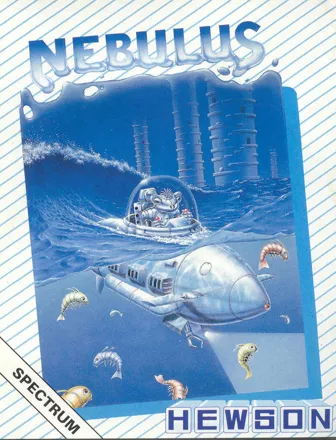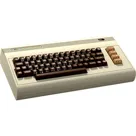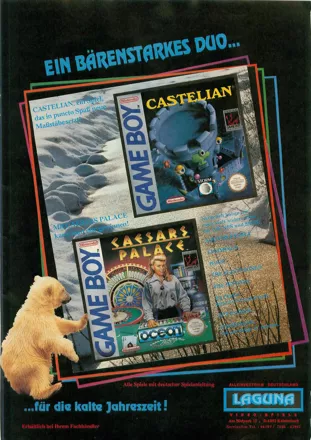Tower Toppler
Description official descriptions
You play a small green guy who needs to blow up eight towers because their presence is somehow poisoning the water of planets which could potentially be ideal colonies. Unfortunately, you need to get to the top of these towers to blow them up.
You make your way up to the top of the tower via walkways around the outside of the towers. You need to jump over, kick, and run from various enemies in your journey to the top. Most vertical movement is achieved by jumping onto moving ledges at the right moment.
The game was considered revolutionary in its time for its graphic technique. As the main character walked around the outside of the tower, the character was fixed in the middle of the screen while the tower itself rotated. This gave it a pseudo-3D effect.
Towers are linked together via a voyage through the sea in your trusty MK.7 submarine. This plays out as a side-scrolling collect-'em-up in which bonus points can be obtained.
Spellings
- キョロちゃんランド - Japanese Famicom / Game Boy spelling
Groups +
Screenshots
Promos
Credits (Commodore 64 version)
4 People
| Written by | |
| ©1987 |
|
| Produced in USA by |
|
| Loading screen (US version) |
|
Reviews
Critics
Average score: 76% (based on 43 ratings)
Players
Average score: 3.6 out of 5 (based on 55 ratings with 2 reviews)
Dismal instructions and some random elements try but fail to scupper a classic
The Good
The concept is delightfully original - it's very much a platform game with a difference, and the level arrangements mean that progress involves advance planning and timing, rather like Lemmings or Bombuzal. The time limits are well-judged, giving you a chance to recover from mistakes and plan your move.
The 3D routines used give the game a fresher feel
The Bad
The instructions this version comes with are thoroughly hopeless, completely failing to explain the use of moving ledges (and thus, the entire system of progress up the towers) and really needed visual representations of each of the game's features alongside the explanations. For my first few goes I got absolutely nowhere, and only got into it through much persistence.
The Bottom Line
The kind of game which was common in the 80s but unusual today - a simple idea (climbing to the top of a succession of towers before triggering a destruction sequence - the towers involve a complex of lifts, stairways and gaps, as well as various moving hazards that can or can't be shot) executed brilliantly.
Incidentally, the PC remake is pretty ugly, other than the bonus levels (the rendered graphics are samey and have no character) - you'd be better off to find this version and play it via an emulator.
Atari ST · by Martin Smith (81712) · 2023
The Good
The pseudo 3D effect of the tower looks very impressive, especially back then. In a way it is a precursor to the use of prerendered graphics. It was a clever new use of sprites and the Amiga and Atari ST versions look very colorful.
The levels have a couple of nice puzzle elements. For example, at some points you have to shoot the blue blocks around the corner to clear the way, or you have to jump against walls in order to fall straight down. The first two towers pose a fair challenge, and the bonus levels where you shoot fish for extra time add some variety to the game.
The Bad
Starting from about tower 3 or 4, the difficulty is just way too high. Jumping over enemies requires pixel perfect timing or you'll just fall into the water. Walk a few pixels too far and you've basically cornered yourself on the edge of a platform; turn around and you'll fall backwards, often to your death.
There are disappearing platforms and slippery platforms, but they are not visually different from regular platforms. There are doors leading to the opposite side of the tower, but often these are trap doors that lead to nowhere and make you fall down again. This turns the later levels into a game of finding and remembering all the booby traps.
The last tower in mission #1 even ends with 4 identical doors and you'll just have to try which one is the real exit, the others just send you falling down again. The mission #2 towers are even worse, the first tower is basically a series of "gotcha" doors and platforms.
On top of all of that you have limited time to complete each tower. It is far too common to slip up near the top and fall all the way down to the beginning. Often you simply won't have enough time left to make it back to the top again, so the best strategy is to jump into the water to lose a life to reset the timer. The timer is a form of artificial difficulty and it would be much better game without a time limit.
The Bottom Line
An interesting game which still looks great today. But the gameplay relies too much on memorizing booby traps and pixel perfect timing, a gameplay style that has not aged well.
Amiga · by BdR (7191) · 2018
Trivia
1001 Video Games
Nebulus appears in the book 1001 Video Games You Must Play Before You Die by General Editor Tony Mott.
Extra levels
In the Amiga, Atari ST and Acorn versions on the title menu screen, players can select Mission #1 or Mission #2 using the function keys. Mission #1 has the same 8 towers as the 8-bit versions, and Mission #2 is essentially a hard-mode with 8 new towers.
Atari ST port
Hewson gave the port to the Atari ST to an external company, but after three month there still was no progress. So John M. Phillips took over the conversion and finished it in a single month.
Canceled ports
John Romero actually did the Apple IIe port of Tower Toppler but Epyx canceled the port along with all their other game ports when they were strapped for cash because they were pouring all their money into Atari Lynx launch title development. The Apple IIe version was in 16-color double-res and used page-flipping. Romero showed it off at the 1989 AppleFest in Kansas City.
The game was also ported to the Atari XE Game System, but never released. Copies of the cartridge surfaced in the late 90s, and it turned out that the XE version ran in black and white on PAL systems, except on poor display systems, where the black and white patterns turned into colours due to cross-talk on low-bandwidth colour signals. On any NTSC system the game would run in full color, looking pretty close to the 7800 version. Since the prototype uses the Tower Toppler name it probably was intended for US release, so the developers would be expecting the game to display in color and not black and white.
Graphics
For some reason, the title screen is in 16 colors only in the EGA version. The Tandy/PCjr version uses the 4 color CGA title screen, however all other screens (including the game itself) are in 16 colors.
Japanese version
In Japan, where the game was released as Kyorochan Land, the green colored frog was replaced by Kyorochan, a parrot-like cartoon bird who serves as the mascot of Moringa & Co., a confectionery company.
Remake
A remake of this game has been written to work on modern hardware/OS. See the related sites section for a download link.
Awards
- ACE
- October 1988 (issue #13) - Included in the Top-100 list of 1987/1988 (editorial staff selection)
- Amiga Power
- May 1991 (Issue #00) - #14 in the "All Time Top 100 Amiga Games"
- Commodore Format
- April 1991 (Issue 7) - listed in the A to Z of Classic Games article (Great)
- January 1992 (Issue 16) - Cf's all time Top Ten Essential Mega Games
- March 1994 (Issue 42) Heaven – The Path to Righteousness: 20 Essential Games
- November 1994 (Issue 50) – #35 The All-Time Top 50 C64 Games
- Computer and Video Games
- May 1988 (issue #79) - Golden Joystick 1988 Award: Winner in category Best Original Game of the Year
Information also contributed by Lev Epshteyn, John Romero, and Игги Друге.
Analytics
Related Sites +
-
Tower Toppler on the Game Boy Advance
On April 5, 2004, a programmer operating under the alias of "Foxy" released version 1.1 of a port of this game for the Game Boy Advance. -
Tower Toppler port on Sourceforge
A free, downloadable re-implementation of the game for many modern computer platforms.
Identifiers +
Contribute
Are you familiar with this game? Help document and preserve this entry in video game history! If your contribution is approved, you will earn points and be credited as a contributor.
Contributors to this Entry
Game added by Gene Davison.
Antstream added by firefang9212. Commodore 64, Amiga added by Johnny "ThunderPeel2001" Walker. NES, Atari 7800, Game Boy added by RKL. Symbian, Acorn 32-bit added by Kabushi. Atari ST, Amstrad CPC, ZX Spectrum added by Martin Smith. Wii added by gamewarrior.
Additional contributors: RKL, Servo, John Romero, chirinea, Alaka, Pseudo_Intellectual, BdR, Cantillon, Rik Hideto, Jo ST, FatherJack.
Game added April 23, 2001. Last modified December 15, 2024.


























